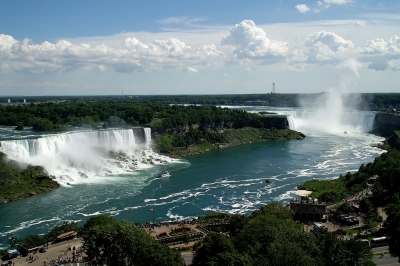
Niagara Falls is a group of three waterfalls at the southern end of Niagara Gorge, spanning the border between the province of Ontario in Canada and the state of New York in the United States.
Comprised of three waterfalls — American Falls, Horseshoe Falls and Bridal Veil Falls — Niagara Falls water stems from the upper Great Lakes and the river is estimated to be 12,000 years old. The wonder of the falls has intrigued many and has prompted daredevils to “conquer” the falls in various contraptions from wooden barrels to rubber balls.
Niagara Falls consists of two waterfalls on the Niagara River, which marks the border between New York and Ontario, Canada: the American Falls, located on the American side of the border, and the Canadian or Horseshoe Falls located on the Canadian side. To the right of the American Falls is a smaller waterfall that has been separated from the American Falls by natural forces, which is usually called Bridal Veil Falls.
It is estimated that 12,000 years ago when the falls were formed, the edge of the falls was as much as seven miles further down river than it is today. Until the 1950s, when the flow of water began to be controlled, the brink of the falls moved backward an estimated three feet every year because of erosion.
The water that runs over the falls comes from the Great Lakes. Ninety percent of the water goes over the Horseshoe Falls. Originally, as much as 5.5. billion gallons of water per hour flowed over the falls. Today the amount is controlled by the Canadian and American governments to slow erosion. In addition, some of the water is diverted to provide power for the United States and Canada, making Niagara Falls the largest source of electric power in the world.
The Horseshoe Falls are 170 feet high. The brink of the falls is approximately 2,500 feet from one side to the other. The American Falls are 180 feet high and 1,100 feet long.
The river below Niagara Falls averages 170 feet deep. Daredevils who go over the falls usually hit the bottom of the river before popping back to the surface.
Credit : History
Picture Credit : Google




